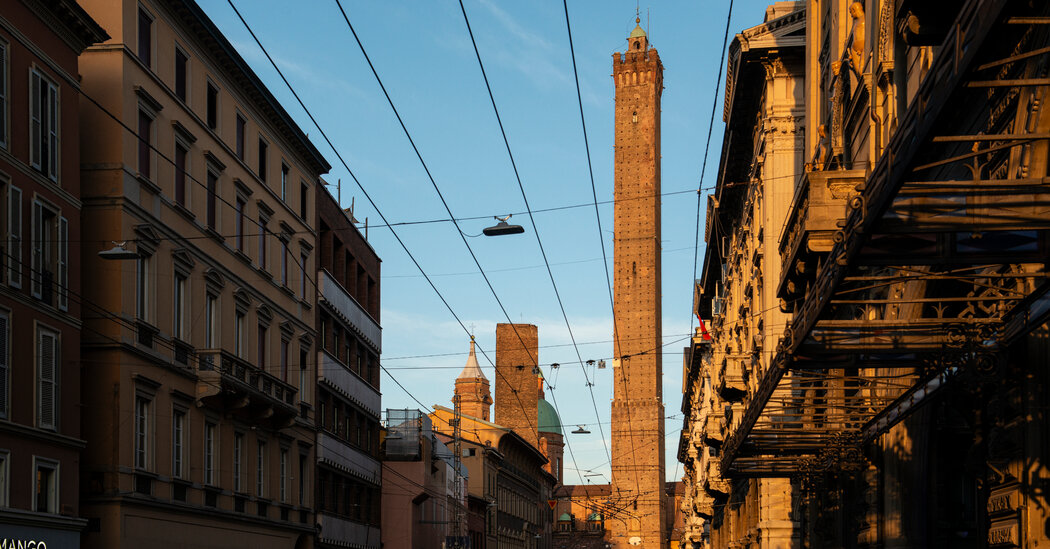Leaning for centuries with a worrying inclination, the Garisenda Tower in Bologna has suffered insults and traumas. Dickens called it “sufficiently unpleasant,” if extraordinary, while Goethe said it was “a disgusting sight.” And then there were the earthquakes, the Allied bombing of the city during the Second World War and the urbanization that destroyed other towers.
The Garisenda has resisted all this, a beloved symbol of this medieval city, a reminder of a past when important families or communities erected towers to remind others of their status and for defense.
But now Garisenda is in trouble.
After sensors attached to the monument, which hangs at a 3.6-degree angle, detected “anomalous movements” last year, alarmed experts issued what was called a “technical code red.”
In October, the Garisenda was cordoned off, with bright red protective barriers placed along part of its perimeter to limit damage if the tower fell, and a group of experts began working on plans to safeguard it for the future, as he watched for signs of impending trouble.
“It's like a patient in intensive care, there are 64 instruments that continuously monitor his vital parameters,” explains Gilberto Dallavalle, structural engineer responsible for the stabilization work on the 157-foot-tall tower since 1997.
He and other experts called in to safeguard the tower have now proposed a solution, looking for the answer in another famous leaning tower. Bologna's mayor, Matteo Lepore, announced last week that the city will adopt a temporary system of pylons and cables that has proved a success in Pisa, where the most famous leaning tower is located.
The idea is that two pylons are attached to a special structure on the tower with cables that should exert a counterforce in case the tower starts to tilt more dangerously.
Once the Garisenda has been stabilized so that the operators can operate safely, it will be possible to proceed with shoring the tower, in particular the foundation, by injecting a mixture of mortar compatible with selenite into a cavity in the base. A final phase will involve the restoration of the upper parts of the tower to ensure its stability for years to come.
“We need to secure the situation as soon as possible so that it doesn't get worse,” so more informed decisions can be made, Lepore said, referring to the initial phase of the work.
Bologna may be best known for its rich food (one of its nicknames is “la grassa”, the fat one); her university, which is the oldest in Italy (another of her nicknames is “la dotta”, the learned one); and its kilometers of arcades, which three years ago were included in the list of UNESCO world heritage sites.
But it was also once a city of many towers, a medieval Manhattan (and yes, hence yet another nickname, “la turrita”, the turrets).
The towers, which once numbered around 100, have now largely disappeared, demolished over the centuries or incorporated into modern palaces and buildings. Among the 20 or so remaining, the Garisenda and its much taller neighbor, the Asinelli, have become the hub of the city's well-preserved medieval center.
Precious symbols of the city, the towers are omnipresent: on postcards, on souvenir magnets, even on the gigantic chocolate Easter eggs which bore their design on a marzipan surface.
Built in the 12th century by the Garisendi, a wealthy local family, the leaning tower began to lean while it was under construction and was shortened by about 40 feet in the 14th century for fear that it might collapse. Over the centuries it has suffered considerable wear, including exposure to the elements and two large fires. For at least 250 years blacksmiths used a forge built inside the base of the tower which significantly deteriorated the fragile selenite stones at the base. The forge remained in operation until the end of the 19th century.
Modern concerns about the tower's stability began about 25 years ago and it has been closely monitored ever since.
Those efforts were intensified about five years ago, when it became apparent that “the pace of deterioration had increased,” said Raffaela Bruni, the engineer who heads the expert committee tasked with saving the tower. In 2021, the base was ringed by thick steel cables and wooden planks (imagine oversized dental braces) and dozens of sensors and other monitoring tools that now detect even the smallest shifts.
Currently, safeguards in place keep visitors about 20 meters away from the base of the tower.
The expert committee decided on the truss system after a recent fact-finding trip to Pisa, where it determined that the same system could be used with some modifications. If all goes well, the pylons should be ready within six months.
In Pisa, work done on the tower increased its expected lifespan by another 300 years, said Massimo Majowiecki, an engineer from Bologna, who worked in Pisa and is now part of the team in his hometown. The costs of maintaining Italy's vast cultural heritage, he noted, are “a huge burden, but they also create a lot of experience.”
There is no way to judge whether Bologna's intervention will work, or for how long, but engineers hope computer modeling can help. A team from the University of Bologna is developing a digital twin for the Garisenda to simulate the effects of possible solutions.
For now, despite media reports casting doubt on the tower's stability, the local community seems mostly optimistic.
The Garisenda “has been through a lot and has never fallen,” said Maurizio Pizzirani, whose wife owns the Hotel Garisenda, a small inn overlooking the towers.
The hotel's website now gets considerable traffic, he said, thanks to a 24-hour webcam outside a window in the hotel's breakfast room overlooking the towers, keeping tabs on the business. (Three towers were demolished decades ago to make way for the building that the hotel partially occupies.)
Like other locals, Pizzirani had opinions about the best course of action to take (starting with rerouting large buses), although he acknowledged that the tower had “no instruction manual.”
Whatever the final solution, work on the tower is expected to be too expensive for the local government to handle alone.
A fundraising campaign promoted by the Municipality of Bologna reminds us that the towers are part of the city's history and says “now you can be part of it too”. So far the campaign has raised 4 million euros, or $4.3 million, according to a city spokesperson, which has covered the costs of the work done so far. The Ministry of Cultural Heritage has another 5 million euros for the restoration, and the Region will also intervene.
In the coming weeks, the installation of rockfall protection nets will be expected at the base of the tower in front of the Torre degli Asinelli and the adjacent baroque Basilica dei SS. Bartolomeo and Gaetano to limit damage in the event of a collapse.
The church is most at risk, but a recent visit inside showed no evidence that the priests had planned for the worst.
“Having no specific expertise in the matter, I stick to what the Municipality tells us,” said Reverend Stefano Ottani, parish priest of the basilica. “We were not told to limit access or close the basilica, so we are keeping it open.”
Mrs. Bruni, the engineer, offered a different explanation: “They have great faith in the Lord,” she said with a smile.





